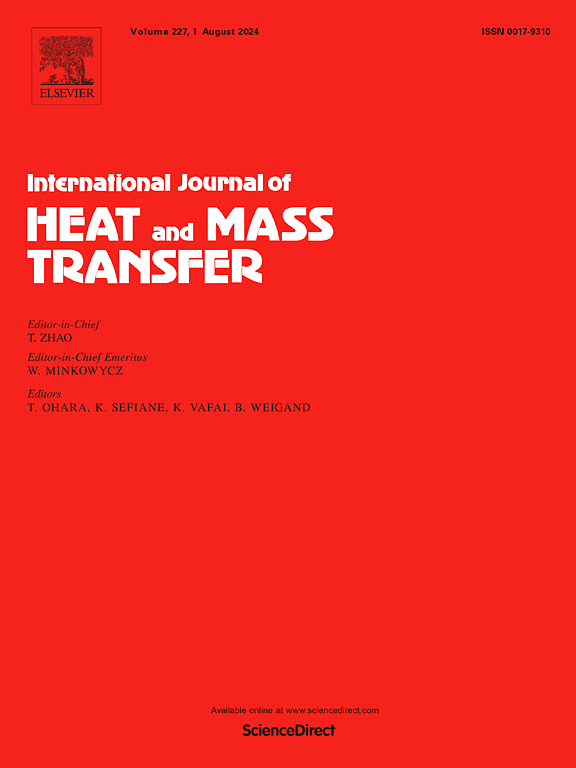Flow and heat transfer characteristics of supercritical CO2 in serpentine tubes under semi-circumferential heating conditions
IF 5
2区 工程技术
Q1 ENGINEERING, MECHANICAL
International Journal of Heat and Mass Transfer
Pub Date : 2024-11-02
DOI:10.1016/j.ijheatmasstransfer.2024.126304
引用次数: 0
Abstract
The tubular solar receiver is one of the most promising candidates for direct supercritical carbon dioxide (S-CO2) solar receivers, which can improve the pressure-bearing performance by increasing the wall thickness of the tube. However, increasing wall thickness induces larger conductive thermal resistance, leading to higher wall temperature and lower thermal efficiency of the receiver. The serpentine tube can enhance the convective heat transfer, mitigating the negative impacts of the increased wall thickness. Nonetheless, the flow and heat transfer characteristics of S-CO2 in serpentine tubes under semi-circumferential heating conditions require further investigation. In this work, the flow and heat transfer characteristics of S-CO2 in a serpentine tube under semi-circumferential heating conditions were numerically investigated. The results showed that in high Reynolds number flows, the radial resultant buoyancy force, dominated by centrifugal buoyancy, induces secondary flow in the tube, improving the field synergy of the cross-section inside the tube. Under the influence of secondary flow, the high-temperature S-CO2 accumulates on the heated side of the concave area and on the insulated side of the convex area, causing local heat transfer deterioration in such areas, but the secondary flow enhances the overall heat transfer performance of the serpentine tube. Compared to circumferential heating, the heat transfer coefficient with semi-circumferential heating is enhanced in the concave areas while deteriorated in the convex areas.
半环流加热条件下蛇形管中超临界二氧化碳的流动和传热特性
管式太阳能接收器是最有前途的直接超临界二氧化碳(S-CO2)太阳能接收器之一,它可以通过增加管壁厚度来提高承压性能。然而,增加管壁厚度会产生较大的传导热阻,导致管壁温度升高,降低接收器的热效率。蛇形管可以增强对流传热,减轻壁厚增加带来的负面影响。然而,蛇形管中 S-CO2 在半环流加热条件下的流动和传热特性还需要进一步研究。在这项工作中,对半圆形加热条件下 S-CO2 在蛇形管中的流动和传热特性进行了数值研究。结果表明,在高雷诺数流动中,以离心浮力为主的径向结果浮力在管内引起二次流动,改善了管内横截面的场协同作用。在二次流动的影响下,高温 S-CO2 聚集在凹面区域的加热侧和凸面区域的隔热侧,导致这些区域的局部传热恶化,但二次流动提高了蛇形管的整体传热性能。与圆周加热相比,半圆周加热的传热系数在凹面区域有所提高,而在凸面区域则有所降低。
本文章由计算机程序翻译,如有差异,请以英文原文为准。
求助全文
约1分钟内获得全文
求助全文
来源期刊
CiteScore
10.30
自引率
13.50%
发文量
1319
审稿时长
41 days
期刊介绍:
International Journal of Heat and Mass Transfer is the vehicle for the exchange of basic ideas in heat and mass transfer between research workers and engineers throughout the world. It focuses on both analytical and experimental research, with an emphasis on contributions which increase the basic understanding of transfer processes and their application to engineering problems.
Topics include:
-New methods of measuring and/or correlating transport-property data
-Energy engineering
-Environmental applications of heat and/or mass transfer

 求助内容:
求助内容: 应助结果提醒方式:
应助结果提醒方式:


